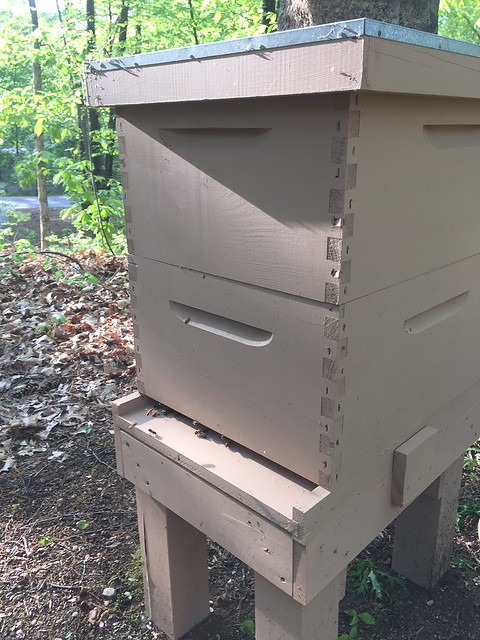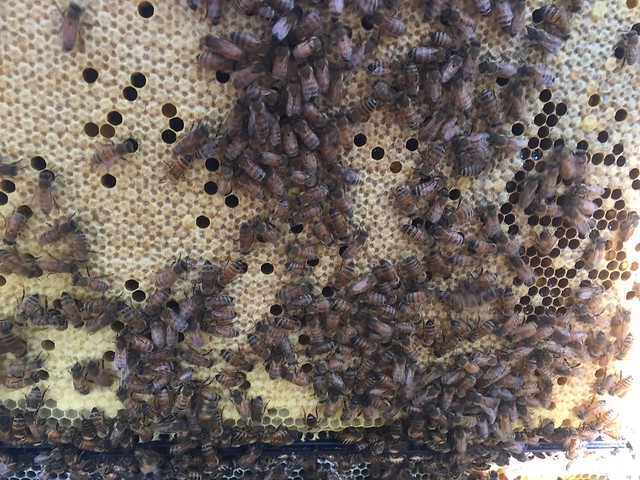Last Friday Grace & I did a hive inspection to gauge the girl's progress in building out the remaining frames in the brood box. They're doing great, and have filled 75%-80% of the frames with drawn comb, so it's time to add a second box.
The second box is identical to the first: 10 frames for them to build on. As they finish off their work on the first box, the bees will move up into the second and continue to build.
The whole point of this is to grow a strong, stable, healthy hive with ample space for both resources and brood. The queen will continue to lay eggs in the second box, and the bees will also produce honey & store pollen in there as well. And as I mentioned before, the honey in these boxes are for the bees to use to feed themselves and nourish the new larva. It's not for me to harvest. That'll come down the road only after they've successfully built out the second box to capacity.
Here's what the hive looks like now:

Wanted to document some of the more interesting finds during the inspection.
This is a frame of comb that has been nearly 100% built out.
- If you look along the left side, you'll see some open "uncapped" comb with little crescent shaped larva in it. They’re the white-ish things in the comb that look a little like a slug.
- Just to the right of the larva is capped brood comb. It’s the butter yellow comb in the left third of the frame. The brood comb has a slightly raised texture to it. After the larva reach a certain point, the worker bees cap their comb to allow them to pupate and grow into adult bees much like a caterpillar develops into a butterfly while in its chrysalis.
- In the center of the frame, you can see the buttery yellow comb changes both in color and texture. The darker colored capped comb is stored honey. The capping has a slight indentation to it vs. the raised quality of the brood comb. Don’t know why this is, but it’s one of the ways of telling what kind of comb you’re looking at.
- Along the very bottom edge of the frame, notice the puffed up individual combs that are somewhat bullet shaped. This is brood comb, but instead of worker bees, male drones are developing in there. Drones are larger than workers and need a larger space in which to develop. For the most part, drone brood comb is found at the edges of the frame and in much, much fewer numbers than worker brood.
- The empty comb to the far right probably had honey in it, or it may have had brood. The darker color of the comb tells me it’s been used before. Bees “polish” the comb after each use, and this polishing turns the comb darker. What I don’t know & need to research is do the bees reuse comb cells strictly for the same purpose? For example, if it starts out as a brood comb, does it forever stay a brood comb, or do they change it up at times and put honey in a comb that once housed brood?

The photo below is a closer view of the brood comb (both open & capped) from a different frame in the hive.
- You can see the bees have stored pollen in the comb cells along the right hand side of the photo. They pack the pollen down into the comb with their heads. Pollen is their protein source and a key component in honey production as well. In fact, they flavor and color of honey will be directly impacted by the type of pollen the bees bring back from their foraging flights each day.
- The open comb cells in the middle of the capped brood are cells from which a new worker bee has recently emerged. Upon entering the world, the first thing a new bee does is clean and polish her cell so it’s ready to be reused as soon as needed.

This final pic shows capped honey in the upper two-thirds of frame. (The lower left corner of the photo looks to be brood.) You can get a sense for the dimpling inward texture of the capping on the honey cells. The hollowed out comb cells are empty, having been used as food for the hive.

Will check the hive in another couple weeks or so to see what kind of progress they're making on the new box. The pace should really start to ramp up now as new bees are emerging every day.